What is a Messenger Bot and How To Build One Easily!
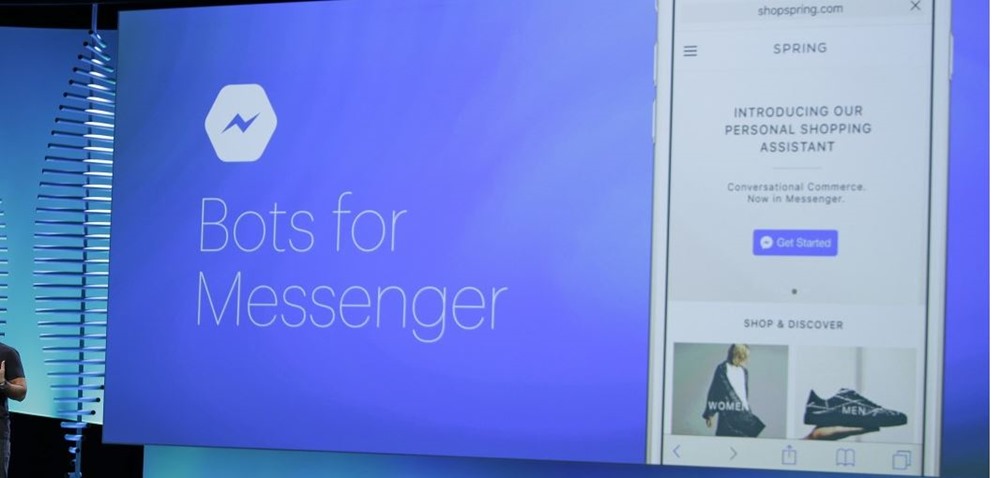
A bot is simply a software which can talk to you and help you get things done. The reason they are suddenly so important is that now they have come on mainstream messengers like Kik, Telegram, Slack and most importantly in April 2016, on Facebook Messenger.
Contents
Why should you care?
People are now downloading fewer apps and spending more time on messaging apps. For the first time there are more people active on Big 4 messaging apps than Big 4 social networks. This is where it is the easiest to reach your potential customers on a messenger app, as they love to hang out here.
“More than 900 million people are active on Facebook messenger, A messenger bot is your brand’s real estate on it”
Can I build a bot for any business?
In the past 2 months, since Facebook has released bots for their messenger, there are more than 10,000 developers already working on them. There is a bot for almost anything – Here are some that you can check out.
- For fashion help – Fify bot – http://fify.ai/
- For shopping, booking and ordering – Yellow Messenger – https://www.yellowmessenger.com/
- For news – Wall Street Journal –
- For Reminders – Jarvis – http://hellojarvis.io/
- For Restaurant Recommendations -Meal lou bot – http://m.me/Mealoubot
- For free Startup Resources – Kukie – https://m.me/561402650713020 – I built this one :)
So “Yes” a bot makes sense for any kind of service, content or product based business.
How Difficult is it to Build O?
You can easily make a functional trial bot in 10 minutes (I am not kidding you), but to make and deploy a decent bot it will take at least 7 to 30 days. I will try and tell how to make your first bot in 7 days :)
Step 1 – Starting
The simple way a bot works is if you can figure out all the questions and their right answers about a particular subject and then match them with each other. For example when I wanted to learn how to build a bot, I chose to build one “which could suggest free startup resources to you” (As this is the one subject I know in and out – experience of 18 months of startup life).
For you most, probably it is going to be “Your business“. Some people have also tried making a bot on themselves :P Try this one https://twitter.com/sandimacbot
Step 2 – Structuring the information
Once you have figured out the theme, you need to structure the information into relevant categories and subcategories so that the bot can answer top level questions and also deeper ones on a subject. E.g. for me it was resources for Marketing, Analytics and Design as top level.
For one level deeper
1. Marketing – SEO, Social Media, Content, Growth Hacking, Customer feedback, Lead generation
2. Analytics – Web analytics, Mobile Analytics, Social media analytics, Business analytics
3. Design – Free stock Images and Free Graphics, Background Music, HD Videos, Mockups and Wireframes
Further, all these subcategories have 5 to 8 recommendations each, from where the user can directly directly go the tool’s website. For you it can be your leading to your product page, filling up an email form, getting a table booked, or online ordering for your restaurant.
Step 3 – UI/UX
The best part about building a messenger bot is that you do not need to worry about the UI and the UX. All you need is the images and descriptions “Yay :D”
Step 4 – Let’s build it
There are many tools to build your bot, it depends on how complex you want to go. I will be outlining the tools by which even non coders can build and deploy fully functional bots.
1. Drag and Drop bot makers – you can easily make your facebook and telegram bots on the following tools by just drag and drop
a. Chatfuel – https://chatfuel.com – Drag and drop bot maker for facebook and Telegram
b. Many Chat – http://manychat.com/ – Build FB messenger bots without coding
For more customised but a little complex options you can go in for
2. https://api.ai/ – API.ai – Conversational UX platform
3. https://wit.ai/ – Wit.ai – Natural Language for developers
I built Kuki on Chatfuel without any coding.
This is how my structure looks like –
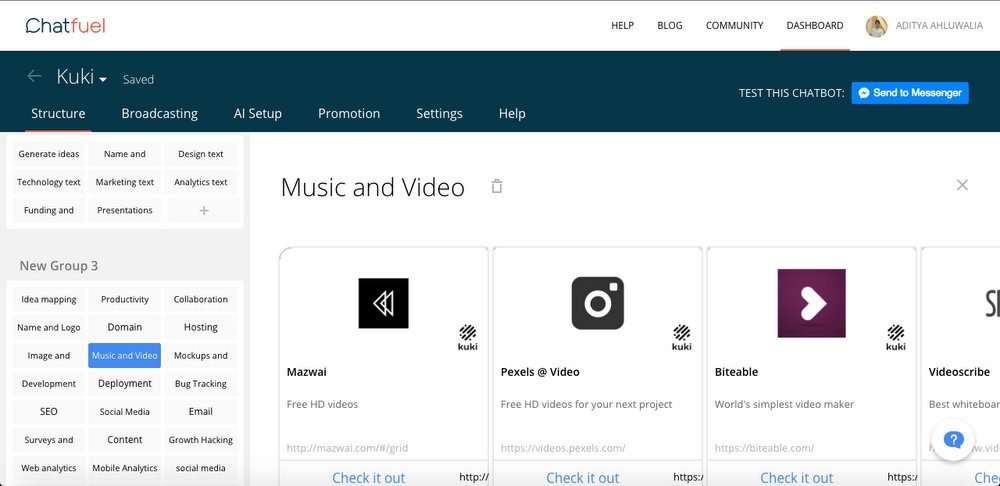
You start building “blocks” which are basically your answers or recommendations for the queries your users might have.
I defined my answers into following groups
- Welcome message (the first message) and Default message (when your bot does not understand the question)
- Conversational Answers for queries like “Hi Kukie”, “Who are you”, “Why were you built”
- Top level answers for queries like “Marketing tools”, “technology stacks”, “Funding and investors” etc
- Detailed answers for queries like “Mobile analytics”, “deployment tools”, “Investor lists” etc
Step 5 – Training it for conversations
Now that you have built the basic structure for your bot. It’s time to train it. So basically your bot will answer the queries or requests of your users. You already have all the answers structured above in blocks. All you need to do is figure out the right questions :) and match them with the answer. One of AI phrase matches looks something like this –
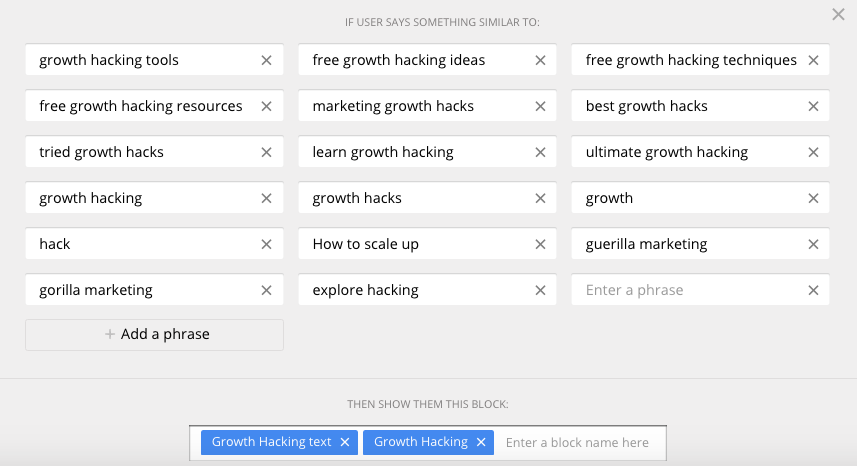
Defining phrases (queries) is easy if you know what your users will ask. I had to make questions individually for categories and subcategories. E.g.
When a user asks “I want to get users on my app” Kuki shows the marketing block which has 7 subcategories under it asking the user what he/she wants to checkout
But when a user asks “I need growth hacking tips” Kuki shows the growth hacking block which recommends 6 tools.
Also when you are starting out it helps if you make it easy for a user to navigate in your bot. For e.g. When someone messages “Help” or “I am confused” to Kukie this is what happens –
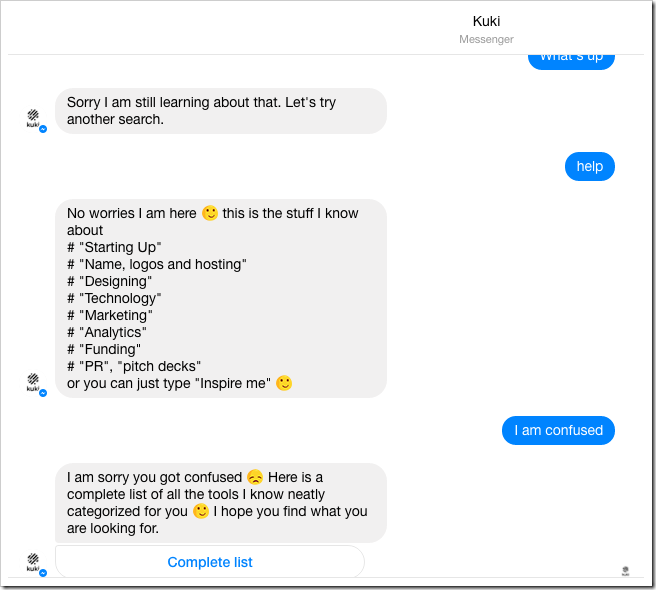
The most important thing while training your bot
When users interact with your bot they ask almost anything like
- Who are you
- Who built you
- What do you do
- What is your website
- What do you know
- How is the weather
- What do you know about Mumbai (or any city for that matter)
And use phrases like
- I love you
- You are awesome
- You are stupid
- You know nothing
- Waddap Dawg (Literally :P)
If you can plan such conversations and hold the users engaged, it really brings a smile to their face. This is how Kuki generally replies to such comments :P
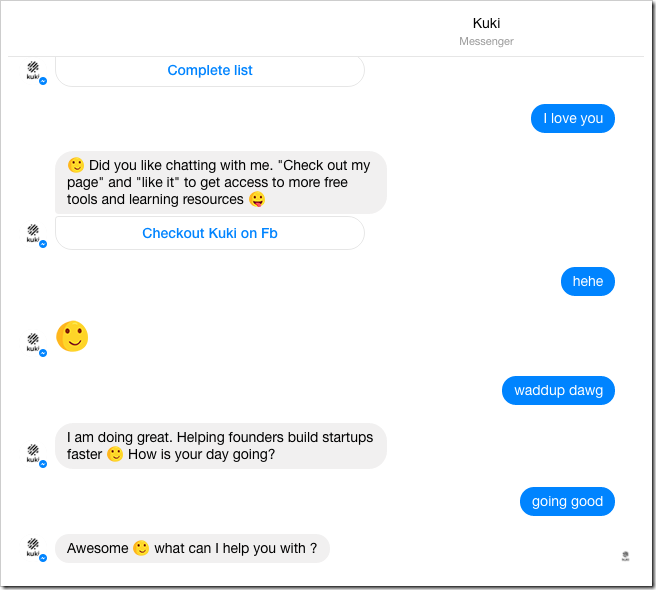
To do all this it would take approximately 7 days if you have all the information i.e questions and answers (including images and links) sorted.
Step 6 – Getting it out
“Build a facebook page or attach it to an existing page and you are good to go :)”
For the first 2 weeks test your bot with your internal group to see what phrases you might have missed out or if the structuring of answers is right. E.g. I had kept Images and Graphics as one category when people were searching for them individually. Also people wanted to learn “how to launch an app” and Kukie kept showing them landing pages. Even after pairing all the questions there will be some which you will miss out.
I started asking for early users to help me train the bot by sharing it in various startup groups. The biggest group for Bots and bot related feedback, learning and show casing on Facebook is Chatbot. Also a few other places you can start getting visibility is –
1. BotHunter – Bot Hunter – curated bots delivered weekly, by a bot – visibility
2. Botpages – Bot pages – Explore the world’s largest open bot directory
3. BotList – Botlist – App store for bots
4. BotExplorer – Bot explorer – A bot to search and explore bots for messenger, slack, Kik and Telegram
There, your first bot is ready in 6 easy steps and 7 days.
Now all you need to do is get users to talk to it and train it so that it gets better at recognizing phrases and giving relevant answers.
Bonus Resources –
1. https://bots.mockuuups.com – Bot UI kits for messenger platform
2. www.botlytics.co – Botlytics Analytics for your bot
The best place to get more users for your bot and check out other awesome bots is on Product Hunt
I feel that in the coming time Bots will be a very part of how brands interact with their consumers simply because –
“A website or an app has UI (User Interface) and UX (User experience) to hold users, a bot has “conversational experience”. The only places I have see people smile, when they use apps is while they are reading “9Gag” or getting matches on “Tinder” :P and oddly enough “Kukie”
“It’s really easy to get them to smile while talking to your bot :)” because of that conversation nature.”
This and the fact that the users don’t need to step out of their favourite messaging apps to interact with your brand has the potential to make 2016 “the year of the Bots”
About the Author: Aditya Ahluwalia is CEO and Co Founder of DIKY a “nearby people recommendations” app. Me and my colleague Rishabh built Kuki bot to share all the learnings we had in our one year of building DIKY. It can recommend 400+ resources to you across 40+ categories to launch, build and scale your business.

I have privacy concerns, which is why I use Threema instead of Facebook Messenger and the like. How can I create a bot for Threema? I understand I’ll have to use their Gateway service. Any ideas?